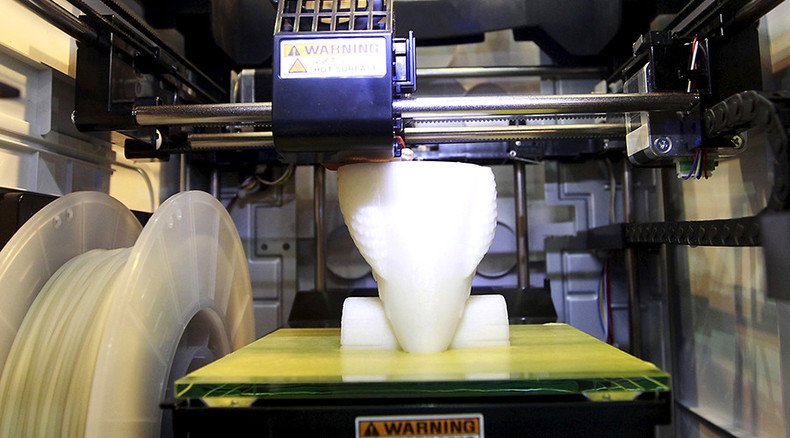Breakthrough in 3D-printing? MIT unveils device molding 10 materials at once

A group of MIT scientists says they have developed the world’s first 3D-printer capable of making ready-to-use objects from 10 different materials at once. The new device, supplied with powerful software, boasts nearly human-free operation.
A research team from MIT’s Computer Science and Artificial Intelligence Lab (CSAIL) has devised what they call a better, cheaper and more user-friendly 3D-printer – MultiFab. The name is due to the unusually high number of materials that it can simultaneously utilize in the manufacturing process – other existing multi-printers are limited to only three at once.
In their study, presented at the August 9-13 SIGGRAPH 2015 conference, the researchers stressed that MultiFab is also much cheaper, while providing a “better” quality of product. The invention also requires significantly less human intervention than traditional 3-D printers, thanks to 3D-scanning software called “computer vision” that the team developed for the device.
The study has been published in the proceedings of SIGGRAPH 2015, as well as in the MIT CSAIL papers.
“A big part of the ability to reduce the cost is the 3-D scanning module,” Javier Ramos, an MIT CSAIL engineer and one of the co-authors of the study said, as quoted by Wired.
“More expensive printers have this mechanical system that sweeps every layer and makes sure it’s flat and properly laid out. We don’t need those extreme mechanical tolerances for this mechanism, given that we use this machine vision system, which is non-contact. It scans and corrects the layer, so we don’t need these very expensive mechanical components,” he added.
“The scanner we developed solves a few high-level problems, which are very high resolution, being able to scan a large area quickly, and then being able to scan materials that are transparent or have some translucency. Those are historically very hard materials to scan,” Ramos said.
The Magic Candy Factory: World’s first-ever 3D printer for chewy sweets (VIDEO) http://t.co/MgpNEAVKh0pic.twitter.com/abEFlhwx3n
— RT (@RT_com) August 29, 2015A special bonus promised by the developers is easy multi-part printing. According to the MIT team, it will be possible to insert specific components – including sophisticated parts such as sensors and circuits – right into the printer. The machine would then incorporate them into the final product by recognizing the parts and continuing to print around them.
MultiFab is a complex system consisting of a central computer, 3D-scanners, and the printer itself. The computer constantly receives 3D-scans from a contactless ‘machine vision’ scanner with a resolution of 40 microns, or less than half the width of a human hair.
The machine compares each printed layer with the scans and detects errors, generating what the researchers call “correction mask.” This software technology frees users from the need to make all the corrections themselves. It also allows the printer to function without expensive mechanical systems that are traditionally installed in such devices to help the user do the fine-tuning.
“Right now, 3D printers are focused on printing form and objects for prototype, but the Holy Grail would be to print out things that are fully functional right out of the printer, combining multiple materials with many properties,” Ramos said as quoted by the IBTimes.
“With MultiFab, we integrate these two worlds of traditional manufacturing with 3D printing, and by putting them together, we can make a whole range of new objects that we are not currently able to make today,” he added.
Eggscellent! Boston chicken to get $2500 3D printed leg http://t.co/7AbCtJPGADpic.twitter.com/WKckYaEqu6
— RT (@RT_com) August 5, 2015The original software combined with the use of low-cost off-the-shelf components in development allowed MultiFab to come in at a relatively ‘cheap’ $7,000 price tag. Potentially comparable analogues cost up to $250,000, the MIT paper said.
The scientists managed to produce a wide range of objects, from optical and LED lenses and fabrics to fiber optics bundles and complex meta-materials. They also created a plastic holder for a metal razor blade and a perfectly-sized case printed around a smartphone, which had been put directly into the printer.
However, the device has its limitations. It is rather slow: printing a small model of a multicolor tire with MultiFab took almost a day and a half. Additionally, the scanner used in MultiFab still has problems with scanning certain types of surfaces such as mirrored finishes.
World’s 1st 3D printed office building to glam up Dubai http://t.co/W3NLbvSw9Ypic.twitter.com/1PhsdI5CQL
— RT (@RT_com) June 30, 2015The team plans to continue their studies and aims to create complex functioning objects containing motors and actuators. The scientists hope their printer will be able to create advanced electronics and even robots in the future. MultiFab could offer new possibilities in electronics, medical imaging, micro-sensing, and telecommunications, they believe.
As for 3D-printing enthusiasts, designers, and small enterprises, the scientists say they will be able to go somewhere to print their models as easily as they go to a print shop to make photocopies on a Xerox machine – in the future.
“Picture someone who sells electric wine-openers, but doesn’t have $7,000 to buy a printer like this. In the future they could walk into a FedEx with a design and print out batches of their finished product at a reasonable price. For me, a practical use like that would be the ultimate dream,” Ramos said in the press-release.












